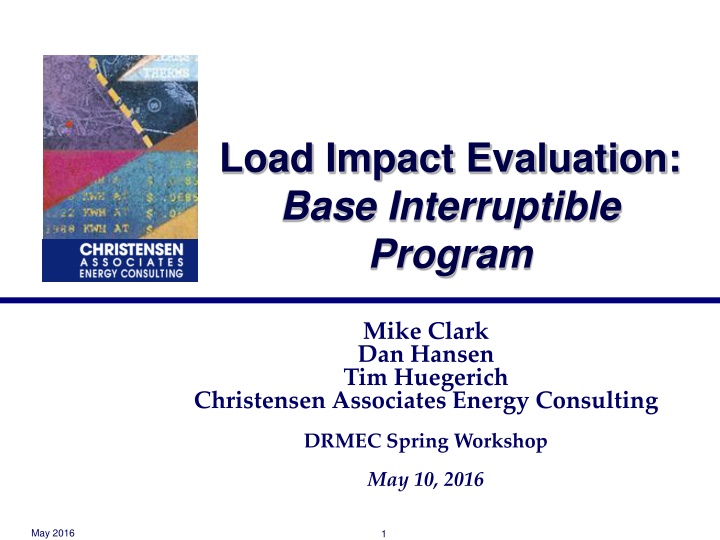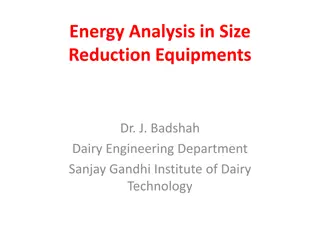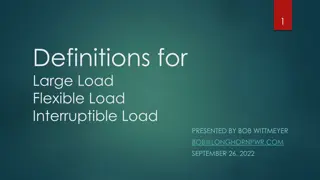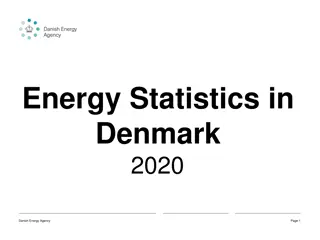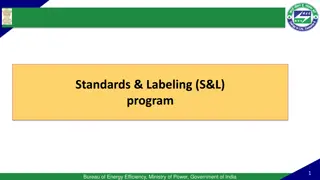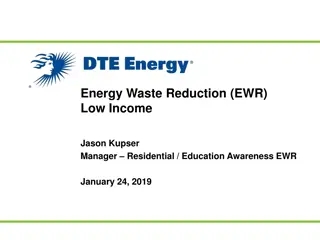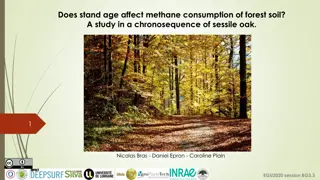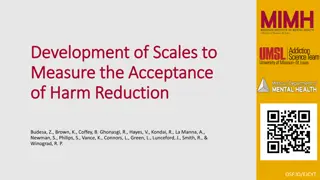Evaluation of Interruptible Program for Energy Consumption Reduction
In this evaluation study, the Base Interruptible Program (BIP) is examined for its impact on load reduction among commercial and industrial customers. The program offers capacity credits in exchange for commitments to reduce energy consumption to Firm Service Levels (FSLs), with consequences for failing to meet these levels. The methodology includes ex-post and ex-ante analyses, outlining the program description, load impacts, enrollment forecasts, and overall conclusions. The study delves into the challenges faced in finding control group customers and the impacts of various test events on load reduction.
Download Presentation

Please find below an Image/Link to download the presentation.
The content on the website is provided AS IS for your information and personal use only. It may not be sold, licensed, or shared on other websites without obtaining consent from the author.If you encounter any issues during the download, it is possible that the publisher has removed the file from their server.
You are allowed to download the files provided on this website for personal or commercial use, subject to the condition that they are used lawfully. All files are the property of their respective owners.
The content on the website is provided AS IS for your information and personal use only. It may not be sold, licensed, or shared on other websites without obtaining consent from the author.
E N D
Presentation Transcript
Load Impact Evaluation: Base Interruptible Program Mike Clark Dan Hansen Tim Huegerich Christensen Associates Energy Consulting DRMEC Spring Workshop May 10, 2016 May 2016 1
Presentation Outline 1. Program Description 2. Ex Post Methodology 3. Ex Post Load Impacts 4. Ex Ante Methodology 5. Enrollment Forecast 6. Ex Ante Load Impacts 7. Summary and Conclusions May 2016 2
1. BIP Program Description Commercial and industrial customers receive a monthly capacity credit in exchange for a commitment to reduce energy consumption to their Firm Service Level (FSL) The FSL represents the customer s minimal operational requirements 30-minute notice of events (also a 15-minute option at SCE) Failure to reduce load to the FSL can result in excess energy charges, an increase in the FSL (and commensurate reduction in capacity credits), re-test events, or de-enrollment from the program May 2016 3
2. Ex Post Methodology Individual regressions are used to estimate BIP ex-post load impacts This method was chosen for two reasons: Difficulty in finding adequate control-group customers Some customers have volatile loads, so even customers that match reasonably well on average may not have a comparable load on a specific day May 2016 4
3. Ex Post Load Impacts: Events Date Day of Week PG&E SCE SDG&E Re-test, 2:00-4:00 p.m. Re-test, 2:00-4:00 p.m. Test, 3:00-7:00 p.m. 2/11/2015 Wednesday 4/23/2015 Thursday 7/30/2015 Thursday Test, 8/28/2015 Friday 1:00-5:00 p.m. Re-test, 2:00-4:00 p.m. 9/22/2015 Tuesday M&E, 9/24/2015 Thursday 1:00-3:30 p.m. Re-test, 11/17/2015 Tuesday 12:00-2:00 p.m. Notes: Re-test event impacts are not presented due to confidentiality concerns (few customers were called). PG&E s 11/17 test event is not included in our study because it occurred after the analysis period ended. May 2016 5
3. Ex Post Load Impacts: Events (2) No. of Available Dispatches 10 / month 1 / day 10 / month 1 / day Hours of Availability Hours of Actual Use No. of Actual Dispatches Utility 180 / year 4 / day 180 / year 6 / day 120 / year 4 / day PG&E 12 5 SCE 2.5 1 SDG&E 4 10 / month 1 May 2016 6
3. Ex Post Load Impacts: PG&E, Summary July 30, 2015 Full Test Event, from 3:00 to 7:00 p.m. 204 participating service accounts Reference Load = 292.4 MW Observed Load = 46.2 MW Load Impact = 246.2 MW (1.2 MW per SAID) FSL = 48.1 MW FSL Achievement = 246.2 / (292.4 48.1) = 101% Was 103% and 102% on the two PY2014 event days (2/6 and 9/11) Average event-hour temperature = 89.7 F The program was not called on either PG&E s or CAISO s peak day, so we cannot report those load impacts May 2016 7
3. Ex Post Load Impacts: PG&E, Hourly 350 300 300 250 250 200 Load Impact (MW) Load (MW) 200 150 150 100 100 50 50 0 0 -50 1 2 3 4 5 6 7 8 9 10 11 12 13 14 15 16 17 18 19 20 21 22 23 24 Hour Event Hours Reference Observed FSL Load Impact May 2016 8
3. Ex Post Load Impacts: SCE, Summary September 24, 2015 M&E Event, notified at 1:00 p.m. and ending at 3:30 p.m. (Results below reflect the only full hour of response, from 2:00 to 3:00 p.m.) 610 participating service accounts Reference Load = 864.1 MW Observed Load = 172.0 MW Load Impact = 692.1 MW (1.1 MW per SAID) FSL = 93.3 MW FSL Achievement = 692.1 / (864.1 93.3) = 90% 93% for single event in PY2014 (2/6/2014) Average event-hour temperature = 90.9 F The program was not called on either SCE s or CAISO s peak day, so we cannot report those load impacts May 2016 9
3. Ex Post Load Impacts: SCE, Hourly 1000 800 900 700 800 600 700 500 Load Impact (MW) 600 400 Load (MW) 500 300 400 200 300 100 200 0 100 -100 0 -200 1 2 3 4 5 6 7 8 9 10 11 12 13 14 15 16 17 18 19 20 21 22 23 24 Hour Event Hours Reference Observed FSL Load Impact May 2016 10
3. Ex Post Load Impacts: SDG&E, Summary August 28, 2015 Test Event, from 1:00 to 5:00 p.m. 5 participating service accounts Usage-based information is not publicly available due to confidentiality concerns Average event-hour temperature = 88.5 F May 2016 11
4. Ex Ante Methodology Ex-ante load impacts are based on the most recent full or test / M&E event day PG&E: July 30, 2015 SCE: September 24, 2015 SDG&E: August 28, 2015 Each customer s ex-ante load impact is set to its ex-post FSL achievement rate: ExPost Achievement = ExPost Load Impact / (Ref. FSL) ExAnte Impact = ExPost Achievement x (Ref. FSL) Load impact is zero if FSL is above the reference load We remove customers who have left BIP Customers who have joined BIP are assigned the program-level FSL achievement rate May 2016 12
4. Ex Ante Methodology (2) Reference loads are simulated using the following: Customer-specific regressions to obtain effect of weather and time-period indicators on usage Ex-ante day types and weather conditions (e.g., August peak month day in a utility-specific 1-in-2 weather year) Load impacts display little to no relationship with weather conditions BIP customers do not tend to have very weather-sensitive loads If they did have weather-sensitive loads, our methodology would produce weather-sensitive forecasts of load impacts May 2016 13
5. Enrollment Forecast PG&E 2015 = 204 service accounts 2016-2026 = 208 SCE 2015 = 610 service accounts 2016 = 579 2017 = 559 2026 = 512 Decrease is largely due to expectation that specific groups of customers will opt out SDG&E 2015 = 5 service accounts 2016-2026 = 7 May 2016 14
6. Ex Ante Load Impacts: PG&E, 2017 vs. 2026 Load Impact (MW) 255.1 255.1 1.23 1.23 Result Type Reference Load (MW) Event Load (MW) Date # SAIDs Temp. ( F) FSL (MW) Aug. 2017 Aug. 2026 Aug. 2017 Aug. 2026 Aggregate Aggregate Per SAID Per SAID 208 208 303.3 303.3 1.46 1.46 48.3 48.3 0.23 0.23 94.7 94.7 49.8 49.8 May 2016 15
6. Ex Ante Load Impacts: PG&E, Ex Post vs. Ex Ante Load Impact (MW) 246.2 255.1 1.21 1.23 Ex Post / Ex Ante Result Type Reference Load (MW) Event Load (MW) # SAIDs Temp. ( F) FSL (MW) Ex Post Ex Ante Ex Post Ex Ante Aggregate Aggregate Per SAID Per SAID 204 208 292.4 303.3 1.43 1.46 46.2 48.3 0.23 0.23 89.7 94.8 48.1 49.8 Ex Post is the 7/30/2015 test event from HE 16 to 19 Ex Ante is the Aug. 2017 PG&E 1in2 peak day from HE 14 to 18 Change in event window accounts for much of the difference between Ex Post and Ex Ante. Using HE 16-19 in Ex Ante => 249.1 MW load impact (which compares to 246.1 in Ex Post). May 2016 16
6. Ex Ante Load Impacts: PG&E, Previous vs. Current Aug. 2017 Forecast Load Impact (MW) When Created Result Type Reference Load (MW) Event Load (MW) # SAIDs Temp. ( F) FSL (MW) Following PY2014 (Previous) Following PY2015 (Current) PY2014 PY2015 Aggregate 203 287.9 41.9 246.0 94.1 47.5 Aggregate 208 303.3 48.3 255.1 94.7 49.8 Per SAID Per SAID 1.42 1.46 0.21 0.23 1.21 1.23 Relatively small differences across forecasts are primarily due to changes in participating customer load profiles (for customers enrolled in both PY2014 and PY2015) May 2016 17
6. Ex Ante Load Impacts: SCE, 2017 vs. 2026 Load Impact (MW) 653.9 602.5 1.17 1.18 Result Type Reference Load (MW) Event Load (MW) Date # SAIDs Temp. ( F) FSL (MW) Aug. 2017 Aug. 2026 Aug. 2017 Aug. 2026 Aggregate Aggregate Per SAID Per SAID 559 512 802.1 738.5 1.43 1.44 148.2 136.0 0.27 0.27 93.2 93.2 84.5 77.2 Per-customer load characteristics remain the same. Outcomes are scaled down to match forecast reduction in enrollment. May 2016 18
6. Ex Ante Load Impacts: SCE, Ex Post vs. Ex Ante Load Impact (MW) 692.1 653.9 1.13 1.17 Ex Post / Ex Ante Result Type Reference Load (MW) Event Load (MW) # SAIDs Temp. ( F) FSL (MW) Ex Post Ex Ante Ex Post Ex Ante Aggregate Aggregate Per SAID Per SAID 610 559 864.1 802.1 1.42 1.43 172.0 148.2 0.28 0.27 91.0 93.2 93.3 84.5 Ex Post is the 9/24/2015 M&E event in HE 15 Ex Ante is the Aug. 2017 SCE 1in2 peak day from HE 14 to 18 Difference in total load impact is largely due to reduction in number of enrolled SAIDs. The per-customer reference loads and load impacts are very similar. May 2016 19
6. Ex Ante Load Impacts: SCE, Previous vs. Current Aug. 2017 Forecast Load Impact (MW) When Created Result Type Reference Load (MW) Event Load (MW) # SAIDs Temp. ( F) FSL (MW) Following PY2014 (Previous) Following PY2015 (Current) PY2014 PY2015 Aggregate 550 773.9 146.3 627.6 93.1 80.0 Aggregate 559 802.1 148.2 653.9 93.2 84.5 Per SAID Per SAID 1.41 1.43 0.27 0.27 1.14 1.17 The current (PY2015) forecast has higher load impacts due to a combination of a higher enrollment (1.6% higher) and higher per-customer load impacts (2.5% higher) May 2016 20
6. Ex Ante Load Impacts: SDG&E We cannot present SDG&E s ex-ante load impacts due to confidentiality concerns May 2016 21
7. Summary and Conclusions BIP continued to provide large load impacts with short notice Program-level performance relative to the FSL was similar to PY2014 PG&E s program is expected to provide a similar level of load impacts throughout the forecast period (2016 to 2026) SCE s program is expected to have some decline in enrollment and therefore load impacts. Load impacts are forecast to decline by ~51 MW (or 7.9%) from 2017 to 2026. May 2016 22
Questions? Contact Mike Clark, Christensen Associates Energy Consulting Madison, Wisconsin mtclark@CAEnergy.com 608-231-2266 May 2016 23
